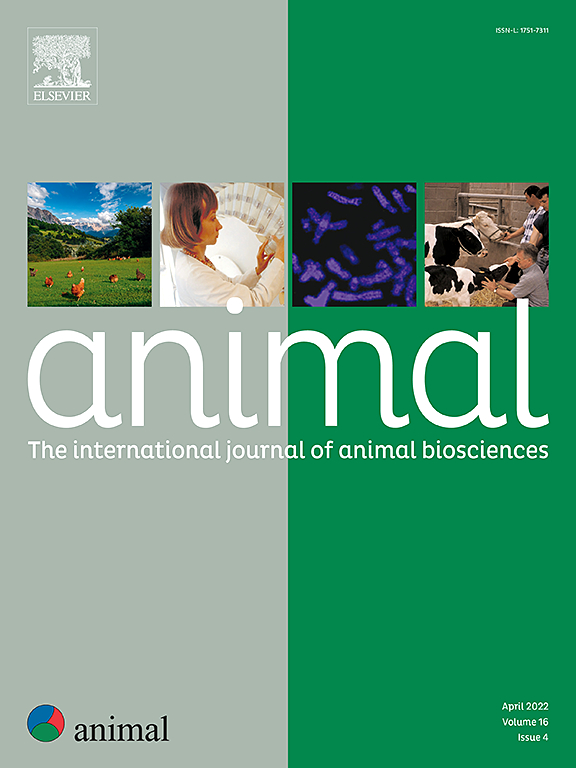饮水盐度对泌乳奶牛水采食量、产奶量及瘤胃生理的影响。
IF 4
2区 农林科学
Q1 AGRICULTURE, DAIRY & ANIMAL SCIENCE
引用次数: 0
摘要
在干旱和半干旱地区,用于家庭、工业和农业目的的淡化海水正在增加。因此,在这些地区,提供给哺乳期奶牛的饮用水的盐度和矿物质浓度比过去低。虽然总溶解固体(tds)高达1000ppm的水被认为是安全的,但较低的盐度水平可能会影响瘤胃生理、饲料和水的摄入量或产奶量。因此,本研究通过添加NaCl人工制造电导率为400 ~ 1 000微西门子(µS) /cm (TDS为200 ~ 500 ppm)的饮用水电导率(EC)为400 ~ 400µS/cm的饮用水电导率(EC)对泌乳奶牛生产性能的影响。在对单个喂食器和槽型饲料进行了2周的适应后,采用拉丁方设计,向4头以色列荷斯坦产哺乳期奶牛提供EC水平分别为400、600、800或1 000µS/cm的饮用水,通过添加浓缩NaCl溶液(槽型中测定的EC平均为418、624、811和1 016µS/cm,分别为209、312、406和508 TDS ppm),分4期,每期18天。每天测量槽内的水EC。每期5 d为洗脱期,10 d为采食量、采食量、产奶量、乳成分产量和体重采集期,3 d为乳、尿、粪和瘤胃液采集期。通过在网状胃内插入记录仪连续记录瘤胃pH和温度。我们分析了全消化道表观消化率、瘤胃液挥发性脂肪酸和NH3,以及水、尿液、粪便和牛奶中的矿物质浓度(Na、Cl、K和N)。饮用水盐度与DM摄入量和能量校正产奶量呈正相关,其中能量校正产奶量在EC为400 ~ 600µS/cm时响应最大。无灰淀粉酶处理的NDF消化率与水盐度呈负相关。水EC对瘤胃挥发性脂肪酸、NH3浓度及采食量均无显著影响。结果提示,饮水矿物质浓度对泌乳奶牛产奶量和瘤胃生理可能有影响,值得进一步研究。本文章由计算机程序翻译,如有差异,请以英文原文为准。
Effect of drinking water salinity on lactating cows’ water and feed intake, milk yield, and rumen physiology
Use of desalinated seawater in arid and semiarid regions for domestic, industrial, and agricultural purposes is on the rise. Consequently, in those regions, drinking water offered to lactating cows has lower salinity and mineral concentrations than in the past. Although water with total dissolved solids (TDSs) of up to 1 000 ppm is considered safe for drinking, lower salinity level may affect rumen physiology, feed and water intake, or milk yield. Therefore, we evaluated the effect of drinking water salinity in an electrical conductivity (EC) range of 400 to 1 000 micro Siemens (µS) / cm (TDS of 200 to 500 ppm) on lactating cows’ performance by artificially creating water EC > 400 µS/cm by adding NaCl. Following 2 weeks of adaptation to individual feeders and troughs, four Israeli Holstein multiparous lactating cows were offered, in a Latin square design, drinking water with EC levels of 400, 600, 800 or 1 000 µS/cm, through addition of concentrated NaCl solutions (measured EC in troughs averaged 418, 624, 811, and 1 016 µS/cm and 209, 312, 406, and 508 TDS ppm, respectively), for four periods of 18 days each. Water EC in troughs was measured daily. Each period included 5 days for washout, 10 days for collecting data of feed and water intake, milk and milk component yields, and BW and 3 days for samplings of milk, urine, faeces, and rumen fluid. Rumen pH and temperature were recorded continually by inserting loggers into the reticulorumen. We analysed the total tract apparent digestibility, rumen fluid volatile fatty acids and NH3, and mineral concentrations (Na, Cl, K, and N) in water, urine, faeces, and milk. Drinking water salinity was positively correlated with DM intake and energy-corrected milk yield, the latter showing the greatest response between EC of 400 and 600 µS/cm. Digestibility of ash-free amylase-treated NDF was negatively correlated with water salinity. There was no significant effect of water EC on rumen volatile fatty acid or NH3 concentrations, or water intake. The results indicate possible effects of drinking water mineral concentrations on lactating cows’ milk yield and rumen physiology, warranting further investigation.
求助全文
通过发布文献求助,成功后即可免费获取论文全文。
去求助
来源期刊

Animal
农林科学-奶制品与动物科学
CiteScore
7.50
自引率
2.80%
发文量
246
审稿时长
3 months
期刊介绍:
Editorial board
animal attracts the best research in animal biology and animal systems from across the spectrum of the agricultural, biomedical, and environmental sciences. It is the central element in an exciting collaboration between the British Society of Animal Science (BSAS), Institut National de la Recherche Agronomique (INRA) and the European Federation of Animal Science (EAAP) and represents a merging of three scientific journals: Animal Science; Animal Research; Reproduction, Nutrition, Development. animal publishes original cutting-edge research, ''hot'' topics and horizon-scanning reviews on animal-related aspects of the life sciences at the molecular, cellular, organ, whole animal and production system levels. The main subject areas include: breeding and genetics; nutrition; physiology and functional biology of systems; behaviour, health and welfare; farming systems, environmental impact and climate change; product quality, human health and well-being. Animal models and papers dealing with the integration of research between these topics and their impact on the environment and people are particularly welcome.
 求助内容:
求助内容: 应助结果提醒方式:
应助结果提醒方式:


